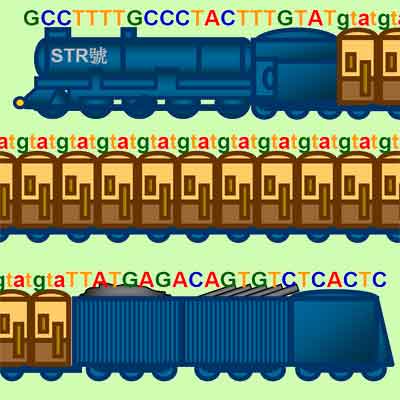 COM.on C.A.4:e22/134-137
Online published on
Dec.13, 2010.
COM.on C.A.4:e22/134-137
Online published on
Dec.13, 2010.doi:10.4236/coca.2010.41022
 COM.on C.A.4:e22/134-137
Online published on
Dec.13, 2010.
COM.on C.A.4:e22/134-137
Online published on
Dec.13, 2010.SHAN Zhiqiong
State Key Laboratory of Genetic Engineering, School of Life Sciences, Fudan University, Shanghai 200433 China
ABSTRACT: The short tandem repeats (STRs) is a kind of unstable short nucleotide repetitive sequence which can be inherited. STRs distribute extensively in human genome. The high polymorphism and heterozygosity, low mutation rate, and convenience for detection make STRs a kind of widely used genetic marker. The examination methods for STRs were also well developed. Today, STRs are applied to gene mapping, linkage analysis, genetic diagnosis and prenatal diagnosis, molecular anthropology, individual identification and paternity identification in forensic sciences, organic transplantation, etc.
Key words: Short tandem repeats; Polymorphism; Genetic marker; Human biology
Recieved: Nov.23, 2010 Accepted: Dec.10, 2010 Corresponding: 09210700047@fudan.edu.cn
《现代人类学通讯》第四卷e22篇 第134-137页 2010年12月13日网上发行
专题综述
短串联重复序列在人类生物学中的应用
单志琼
复旦大学生命科学学院遗传工程国家重点实验室,上海200433
摘要:短串联重复序列是一种可遗传的、不稳定的短核苷酸重复序列,具有基因组中分布广泛、高度多态性、高杂合度、低突变率、检测简便快捷等优点。自开发利用以来,在检测方法及应用领域等方面都得到了不断的拓展,现已广泛应用于基因作图、连锁分析、基因诊断与产前诊断、分子人类学、法医学个体识别和亲子鉴定、器官移植等领域,是目前应用最广泛的遗传标记。
关键词:短串联重复序列;多态性;遗传标记;人类生物学
参考文献 References
1.Litt M, Luty JA (1989) A hypervariable
microsatellite revealed by invitro
amplification of a dinucleotide repeat
with in the cardiac muscle act in gene.
Am J Hum Genet 44: 397-401.
2.Weber JL, May PE (1989)
A bundant class of human DNA
polymorphism which can be typed using
the polymerase chain reaction. Am J
Hum Genet 44: 388-396.
3.Edwards AL, Civitello A, Hammond HA,
Caskey CT (1991)
DNA typing and genetic mapping with
trimeric and tetrameric tandem repeats.
Am J Hum Genet 49:746-752.
4.Crouse CA, Schumm J (1995)
Investigation of species specificity
using nine PCR-based human STR systems.
Forensic Sci Int 143: 47-52.
5. 刘洋,姜丽华,汪运山(2003)微卫星DNA的测定方法.
中国误诊学杂志3:994-995.
6.郑秀芬(2002)法医DNA分析.
北京:中国人民公安大学出版社:383-388.
7. Wang DG, Fan JB, Siao CJ, Berno A,
Young P, Sapolsky R, Ghandour G, Perkins
N, Winchester E, Spencer J, Kruglyak L,
Stein L, Hsie L, Topaloglou T, Hubbell
E, Robinson E, Mittmann M, Morris MS,
Shen N, Kilburn D, Rioux J, Nusbaum C,
Rozen S, Hudson TJ, Lipshutz R, Chee M,
Lander ES (1998)
Large-scale identification, mapping, and
genotyping of single-nucleotide
polymorphisms in the human genome.
Science 280:1077-1082.
8. Dib C, Faure S, Fizames C, Samson D,
Drouot N, Vignal A, Missasseau P, Marc
S, Hazan J, Seboun E, Lathrop M, Gyapay
G, Morissette J, Weissenbach J (1996) A
comprehensive genetic map of human
genome based on 5264 micro-satellites.
Nature 380:14-17.
9 Kang S, Jaworski A, Ohshima K, Wells
RD (1995)
Expansion and deletion of CTG repeats
from human disease genes are determined
by the direction of replication in
E.coli. Nat Genet 10:213-218.
10.王冰梅,庄文越,王雪松,苏铁克(2006)短串联重复序列的研究.北华大学学报(自然科学版)
7: 43-46.
11.Karafet TM, Zegura SL, Posukh O,
Osipova L, Bergen A, Long J, Goldman D,
Klitz W, Harihara S, de Knijff P, Wiebe
V, Griffiths RC, Templeton AR, Hammer MF
(1999)
Ancestral Asian source(s) of New World
Y-chromosome founder haplotypes. Am
J Hum Genet 64: 877-881.
12. Roewer L, Croucher PJ, Willuweit S,
Lu TT, Kayser M, Lessig R, de Knijff P,
Jobling MA, Tyler-Smith C, Krawczak M
(2005)
Signature of recent historical events in
the European Y-chromosomal STR haplotype
distribution. Hum Genet 116:
279-291.
13.李辉,潘悟云,文波,杨宁宁,金建中,金力,卢大儒(2003)客家人起源的遗传学分析.遗传学报.30:
873-880.
14. Bowcock AM, Ruiz-Linares A,
Tonfohrde J, Minch E, Kidd JR, Cavaili-Sforza
LL (1994)
High resolution of human evolutionary
trees with polymorphic microsatellites.
Nature 368: 455-457.
15.Calafell F, Shuster A, Speed WC, Kidd
JR, Kidd KK(1998)
Short tandem repeat polymorphism
evolution in humans. Eur J Hum Genet
6:38-49.